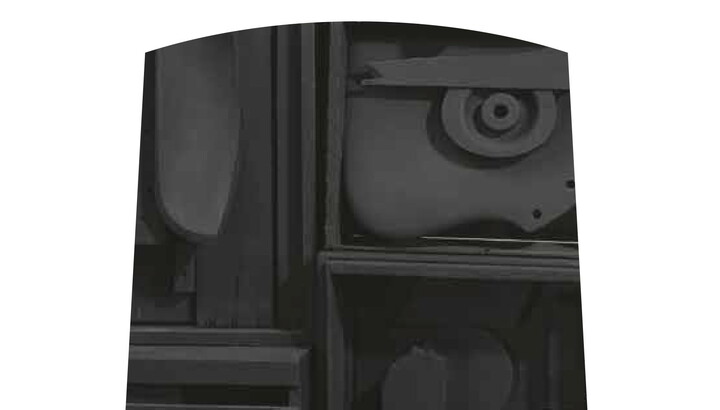







Artwork Images
Photo:
Controls
Lunar Landscape
Object Details
-
Date
1959-1960
-
Object Type
Sculptures
-
Medium
Painted wood
-
Dimensions
86 x 49 x 14 in.
-
Credit Line
Amon Carter Museum of American Art, Fort Worth, Texas, Purchase with funds from the Ruth Carter Stevenson Acquisitions Endowment
-
Accession Number
1999.3.A-J
-
Copyright
Public domain
Object Description
To create Lunar Landscape, Nevelson nailed and glued together fragments of discarded wood objects, including a bedpost, juggling pin, and parts of a chair. Painted in black monochrome, the assembled fragments take on new life as a monumental composition characterized by irregular surfaces and recessed pockets of shadow. The work breaks from conventional modes of sculptural presentation, taking on an appearance more akin to architecture.
Working on a large scale and with scavenged materials, Nevelson defied gender expectations for women sculptors. And by rejecting carving in favor of piecing together found objects, she distanced her process from the then male-dominated spheres of carpentry and welded metal sculpture. Through the creation of her works, which she called “environments,” Nevelson fashioned her own independent creative identity within the art world.
—Text taken from the Carter Handbook (2023)
Additional details
Location: On view
See more by Louise Nevelson
Tags
-
What is assemblage art? What is the history of assemblage art?
How does an artist balance, unity, and variety within a work of art?
How might a work of art reflect an artist’s experiences?
How might a work of art reflect or relate to important moments in history?
-
Grades 4–12
Students will think of a place they have never been but would like to explore. They should consider which objects they would use to create their own assemblage inspired by this place. Students will write about which objects they might choose and why. Then they will sketch their assemblage.
Grades 6–12
Students will use wood scraps and other found objects to create their own assemblage. A cardboard box can be used for the base and students can choose whether or not to paint the box and their objects one solid color before using hot glue or wood glue to assemble their sculpture.
Share Educator Resources
Amon Carter Disclaimer
This information is published from the Carter's collection database. Updates and additions based on research and imaging activities are ongoing. The images, titles, and inscriptions are products of their time and are presented here as documentation, not as a reflection of the Carter’s values. If you have corrections or additional information about this object please email us to help us improve our records.
Every effort has been made to accurately determine the rights status of works and their images. Please email us if you have further information on the rights status of a work contrary or in addition to the information in our records.
Related Works
-
[Indian man], ca. 1910-1925
Charles M. Russell
Plaster, wood, oil paint, and cloth
1961.60
-
Martha Graham - Letter to the World (Swirl), 1940
Barbara Morgan
Gelatin silver print
P1974.21.17
-
Roseate Spoonbill, ca. 1980-85
Scott Gentling, Stuart Gentling
Graphite, opaque and transparent watercolor on paper
2018.26
-
Head (Abstraction), 1916
Robert Laurent
Mahogany
1989.7
-
Zerogram, 2017
Ellen Carey
Dye coupler print
P2018.40
-
The Time Game, 2011
Jane Hammond
Gelatin silver print
P2011.29
-
"49", n.d.
Doug Hyde
Marble
1973.2
-
Untitled, 1970
Luchita Hurtado
Lithograph
1970.86
-
New England Landscape II, 1967
George Morrison
Wood
1968.273



















